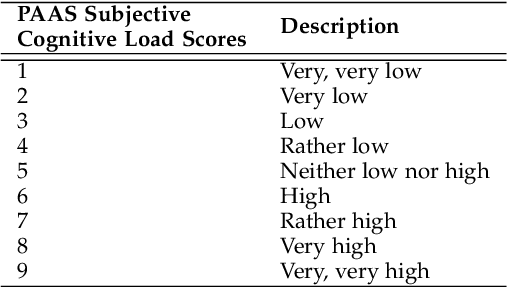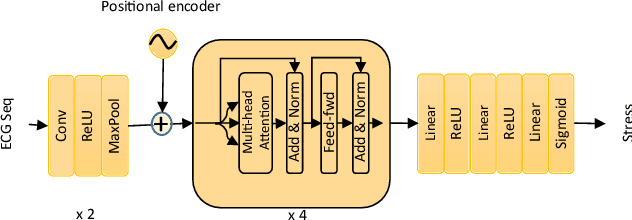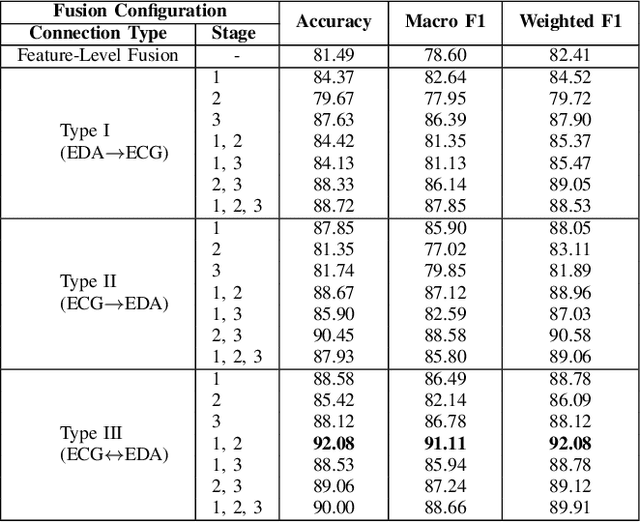Dirk Rodenburg
CLARE: Cognitive Load Assessment in REaltime with Multimodal Data
Apr 26, 2024



Abstract:We present a novel multimodal dataset for Cognitive Load Assessment in REaltime (CLARE). The dataset contains physiological and gaze data from 24 participants with self-reported cognitive load scores as ground-truth labels. The dataset consists of four modalities, namely, Electrocardiography (ECG), Electrodermal Activity (EDA), Electroencephalogram (EEG), and Gaze tracking. To map diverse levels of mental load on participants during experiments, each participant completed four nine-minutes sessions on a computer-based operator performance and mental workload task (the MATB-II software) with varying levels of complexity in one minute segments. During the experiment, participants reported their cognitive load every 10 seconds. For the dataset, we also provide benchmark binary classification results with machine learning and deep learning models on two different evaluation schemes, namely, 10-fold and leave-one-subject-out (LOSO) cross-validation. Benchmark results show that for 10-fold evaluation, the convolutional neural network (CNN) based deep learning model achieves the best classification performance with ECG, EDA, and Gaze. In contrast, for LOSO, the best performance is achieved by the deep learning model with ECG, EDA, and EEG.
Multimodal Brain-Computer Interface for In-Vehicle Driver Cognitive Load Measurement: Dataset and Baselines
Apr 09, 2023



Abstract:Through this paper, we introduce a novel driver cognitive load assessment dataset, CL-Drive, which contains Electroencephalogram (EEG) signals along with other physiological signals such as Electrocardiography (ECG) and Electrodermal Activity (EDA) as well as eye tracking data. The data was collected from 21 subjects while driving in an immersive vehicle simulator, in various driving conditions, to induce different levels of cognitive load in the subjects. The tasks consisted of 9 complexity levels for 3 minutes each. Each driver reported their subjective cognitive load every 10 seconds throughout the experiment. The dataset contains the subjective cognitive load recorded as ground truth. In this paper, we also provide benchmark classification results for different machine learning and deep learning models for both binary and ternary label distributions. We followed 2 evaluation criteria namely 10-fold and leave-one-subject-out (LOSO). We have trained our models on both hand-crafted features as well as on raw data.
A Transformer Architecture for Stress Detection from ECG
Aug 22, 2021


Abstract:Electrocardiogram (ECG) has been widely used for emotion recognition. This paper presents a deep neural network based on convolutional layers and a transformer mechanism to detect stress using ECG signals. We perform leave-one-subject-out experiments on two publicly available datasets, WESAD and SWELL-KW, to evaluate our method. Our experiments show that the proposed model achieves strong results, comparable or better than the state-of-the-art models for ECG-based stress detection on these two datasets. Moreover, our method is end-to-end, does not require handcrafted features, and can learn robust representations with only a few convolutional blocks and the transformer component.
Attentive Cross-modal Connections for Deep Multimodal Wearable-based Emotion Recognition
Aug 04, 2021



Abstract:Classification of human emotions can play an essential role in the design and improvement of human-machine systems. While individual biological signals such as Electrocardiogram (ECG) and Electrodermal Activity (EDA) have been widely used for emotion recognition with machine learning methods, multimodal approaches generally fuse extracted features or final classification/regression results to boost performance. To enhance multimodal learning, we present a novel attentive cross-modal connection to share information between convolutional neural networks responsible for learning individual modalities. Specifically, these connections improve emotion classification by sharing intermediate representations among EDA and ECG and apply attention weights to the shared information, thus learning more effective multimodal embeddings. We perform experiments on the WESAD dataset to identify the best configuration of the proposed method for emotion classification. Our experiments show that the proposed approach is capable of learning strong multimodal representations and outperforms a number of baselines methods.
Classification of Cognitive Load and Expertise for Adaptive Simulation using Deep Multitask Learning
Jul 31, 2019



Abstract:Simulations are a pedagogical means of enabling a risk-free way for healthcare practitioners to learn, maintain, or enhance their knowledge and skills. Such simulations should provide an optimum amount of cognitive load to the learner and be tailored to their levels of expertise. However, most current simulations are a one-type-fits-all tool used to train different learners regardless of their existing skills, expertise, and ability to handle cognitive load. To address this problem, we propose an end-to-end framework for a trauma simulation that actively classifies a participant's level of cognitive load and expertise for the development of a dynamically adaptive simulation. To facilitate this solution, trauma simulations were developed for the collection of electrocardiogram (ECG) signals of both novice and expert practitioners. A multitask deep neural network was developed to utilize this data and classify high and low cognitive load, as well as expert and novice participants. A leave-one-subject-out (LOSO) validation was used to evaluate the effectiveness of our model, achieving an accuracy of 89.4% and 96.6% for classification of cognitive load and expertise, respectively.
 Add to Chrome
Add to Chrome Add to Firefox
Add to Firefox Add to Edge
Add to Edge